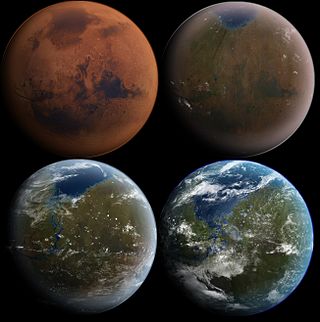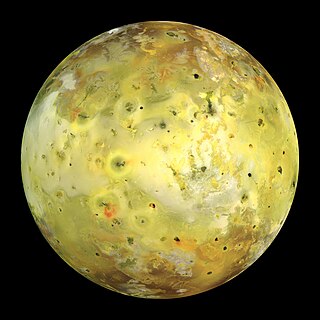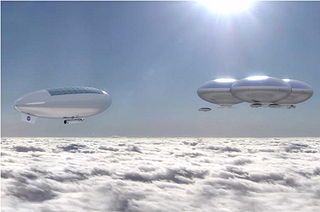Related Research Articles

Terraforming or terraformation ("Earth-shaping") is the hypothetical process of deliberately modifying the atmosphere, temperature, surface topography or ecology of a planet, moon, or other body to be similar to the environment of Earth to make it habitable for humans to live on.

A volcano is a rupture in the crust of a planetary-mass object, such as Earth, that allows hot lava, volcanic ash, and gases to escape from a magma chamber below the surface.

Volcanism, vulcanism, volcanicity, or volcanic activity is the phenomenon where solids, liquids, gases, and their mixtures erupt to the surface of a solid-surface astronomical body such as a planet or a moon. It is caused by the presence of a heat source inside the body. This internal heat partially melts solid material in the body or turns material into gas. The mobilized material rises through the body's interior and may break through the solid surface.

An atmosphere is a layer of gasses that envelop an astronomical object, held in place by the gravity of the object. A planet retains an atmosphere when the gravity is great and the temperature of the atmosphere is low. A stellar atmosphere is the outer region of a star, which includes the layers above the opaque photosphere; stars of low temperature might have outer atmospheres containing compound molecules.
Outgassing is the release of a gas that was dissolved, trapped, frozen, or absorbed in some material. Outgassing can include sublimation and evaporation, as well as desorption, seepage from cracks or internal volumes, and gaseous products of slow chemical reactions. Boiling is generally thought of as a separate phenomenon from outgassing because it consists of a phase transition of a liquid into a vapor of the same substance.
Planetary engineering is the development and application of technology for the purpose of influencing the environment of a planet. Planetary engineering encompasses a variety of methods such as terraforming, seeding, and geoengineering.

Io, or Jupiter I, is the innermost and second-smallest of the four Galilean moons of the planet Jupiter. Slightly larger than Earth's moon, Io is the fourth-largest moon in the Solar System, has the highest density of any moon, the strongest surface gravity of any moon, and the lowest amount of water by atomic ratio of any known astronomical object in the Solar System. It was discovered in 1610 by Galileo Galilei and was named after the mythological character Io, a priestess of Hera who became one of Zeus's lovers.

The geology of Venus is the scientific study of the surface, crust, and interior of the planet Venus. Within the Solar System, it is the one nearest to Earth and most like it in terms of mass, but has no magnetic field or recognizable plate tectonic system. Much of the ground surface is exposed volcanic bedrock, some with thin and patchy layers of soil covering, in marked contrast with Earth, the Moon, and Mars. Some impact craters are present, but Venus is similar to Earth in that there are fewer craters than on the other rocky planets that are largely covered by them. This is due in part to the thickness of the Venusian atmosphere disrupting small impactors before they strike the ground, but the paucity of large craters may be due to volcanic re-surfacing, possibly of a catastrophic nature. Volcanism appears to be the dominant agent of geological change on Venus. Some of the volcanic landforms appear to be unique to the planet. There are shield and composite volcanoes similar to those found on Earth, although these volcanoes are significantly shorter than those found on Earth or Mars. Given that Venus has approximately the same size, density, and composition as Earth, it is plausible that volcanism may be continuing on the planet today, as demonstrated by recent studies.

The colonization of Venus has been a subject of many works of science fiction since before the dawn of spaceflight, and is still discussed from both a fictional and a scientific standpoint. However, with the discovery of Venus's extremely hostile surface environment, attention has largely shifted towards the colonization of the Moon and Mars instead, with proposals for Venus focused on habitats floating in the upper-middle atmosphere and on terraforming.

The terraforming of Venus or the terraformation of Venus is the hypothetical process of engineering the global environment of the planet Venus in order to make it suitable for human habitation. Adjustments to the existing environment of Venus to support human life would require at least three major changes to the planet's atmosphere:
- Reducing Venus's surface temperature of 737 K
- Eliminating most of the planet's dense 9.2 MPa (91 atm) carbon dioxide and sulfur dioxide atmosphere via removal or conversion to some other form
- The addition of breathable oxygen to the atmosphere.

The atmosphere of Venus is the very dense layer of gasses surrounding the planet Venus. Venus's atmosphere is composed of 96.5% carbon dioxide and 3.5% nitrogen, with other chemical compounds present only in trace amounts. It is much denser and hotter than that of Earth; the temperature at the surface is 740 K, and the pressure is 93 bar (1,350 psi), roughly the pressure found 900 m (3,000 ft) under water on Earth. The atmosphere of Venus supports decks of opaque clouds of sulfuric acid that cover the entire planet, making optical Earth-based and orbital observation of the surface impossible. Information about surface topography has been obtained exclusively by radar imaging.
A primary atmosphere is an atmosphere of a planet that forms by accretion of gaseous matter from the accretion disc of the planet's sun. Planets such as Jupiter and Saturn have primary atmospheres. Primary atmospheres are very thick compared to secondary atmospheres like the one found on Earth. The primary atmosphere was lost on the terrestrial planets due to a combination of surface temperature, mass of the atoms and escape velocity of the planet.

The geology of solar terrestrial planets mainly deals with the geological aspects of the four terrestrial planets of the Solar System – Mercury, Venus, Earth, and Mars – and one terrestrial dwarf planet: Ceres. Earth is the only terrestrial planet known to have an active hydrosphere.

The surface of Venus is dominated by volcanic features and has more volcanoes than any other planet in the Solar System. It has a surface that is 90% basalt, and about 65% of the planet consists of a mosaic of volcanic lava plains, indicating that volcanism played a major role in shaping its surface. There are more than 1,000 volcanic structures and possible periodic resurfacing of Venus by floods of lava. The planet may have had a major global resurfacing event about 500 million years ago, from what scientists can tell from the density of impact craters on the surface. Venus has an atmosphere rich in carbon dioxide, with a pressure that is 90 times that of Earth's atmosphere.
John Hoffman was a space scientist who developed instruments for Apollo 15, Apollo 16, Apollo 17, the Pioneer Venus project, and Giotto mission. He also designed the mass spectrometer for the Phoenix Mars Lander mission in May 2008. He was a professor of physics at the University of Texas at Dallas.
Tectonic–climatic interaction is the interrelationship between tectonic processes and the climate system. The tectonic processes in question include orogenesis, volcanism, and erosion, while relevant climatic processes include atmospheric circulation, orographic lift, monsoon circulation and the rain shadow effect. As the geological record of past climate changes over millions of years is sparse and poorly resolved, many questions remain unresolved regarding the nature of tectonic-climate interaction, although it is an area of active research by geologists and palaeoclimatologists.

A planetary surface is where the solid or liquid material of certain types of astronomical objects contacts the atmosphere or outer space. Planetary surfaces are found on solid objects of planetary mass, including terrestrial planets, dwarf planets, natural satellites, planetesimals and many other small Solar System bodies (SSSBs). The study of planetary surfaces is a field of planetary geology known as surface geology, but also a focus on a number of fields including planetary cartography, topography, geomorphology, atmospheric sciences, and astronomy. Land is the term given to non-liquid planetary surfaces. The term landing is used to describe the collision of an object with a planetary surface and is usually at a velocity in which the object can remain intact and remain attached.
Comparative planetary science or comparative planetology is a branch of space science and planetary science in which different natural processes and systems are studied by their effects and phenomena on and between multiple bodies. The planetary processes in question include geology, hydrology, atmospheric physics, and interactions such as impact cratering, space weathering, and magnetospheric physics in the solar wind, and possibly biology, via astrobiology.

Planetary habitability in the Solar System is the study that searches the possible existence of past or present extraterrestrial life in those celestial bodies. As exoplanets are too far away and can only be studied by indirect means, the celestial bodies in the Solar System allow for a much more detailed study: direct telescope observation, space probes, rovers and even human spaceflight.

Mars' carbonate catastrophe was an event that happened on Mars in its early history. Evidence shows Mars was once warmer and wet about 4 billion years ago, that is about 560 million years after the formation of Mars. Mars quickly, over a 1 to 12 million year time span, lost its water, becoming cold and very dry. Factors in Mars losing its water and most of its atmosphere are: the carbonate catastrophe, loss of the planet's magnetic field and Mars' low gravity. Mars' low gravity and loss of a magnetic field allowed the Sun's solar wind to strip away most of Mars' atmosphere and water into outer space.
References
- ↑ James Schombert (2004). "Primary Atmospheres (Astronomy 121: Lecture 14 Terrestrial Planet Atmospheres)". Department of Physics University of Oregon. Retrieved 2009-12-22.
- 1 2 3 4 Nunn, John F. (1998-01-01). "Evolution of the atmosphere". Proceedings of the Geologists' Association. 109 (1): 1–13. Bibcode:1998PrGA..109....1N. doi:10.1016/S0016-7878(98)80001-1. ISSN 0016-7878. PMID 11543127.
- ↑ Kite, Edwin S.; Barnett, Megan N. (2020-08-04). "Exoplanet secondary atmosphere loss and revival". Proceedings of the National Academy of Sciences. 117 (31): 18264–18271. arXiv: 2006.02589 . Bibcode:2020PNAS..11718264K. doi: 10.1073/pnas.2006177117 . ISSN 0027-8424. PMC 7414166 . PMID 32694204.
- ↑ Tian, Meng; Heng, Kevin (2024-03-08). "Atmospheric Chemistry of Secondary and Hybrid Atmospheres of Super Earths and Sub-Neptunes". The Astrophysical Journal. 963 (2): 157. arXiv: 2301.10217 . Bibcode:2024ApJ...963..157T. doi: 10.3847/1538-4357/ad217c .